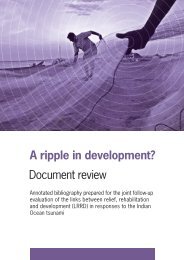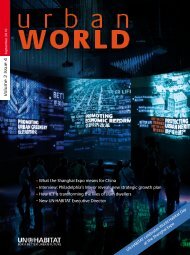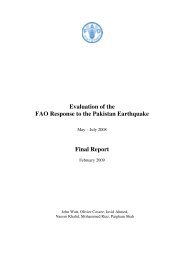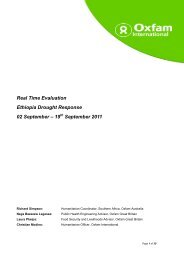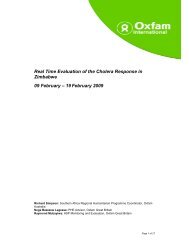Inter-Agency Real Time Evaluation of the Humanitarian ... - alnap
Inter-Agency Real Time Evaluation of the Humanitarian ... - alnap
Inter-Agency Real Time Evaluation of the Humanitarian ... - alnap
Create successful ePaper yourself
Turn your PDF publications into a flip-book with our unique Google optimized e-Paper software.
IA RTE <strong>of</strong> <strong>the</strong> humanitarian response to Pakistan’s 2010 Floods crisis<br />
155. NDMA, with EAD and IASC representatives, define integrated results based monitoring<br />
framework for future emergencies (aligned with single reporting format) which includes:<br />
� measurable progress indicators<br />
� outcome indicators<br />
� level <strong>of</strong> expenditures<br />
� 4 W’s (who, what, where and when)<br />
8 ‐ General Conclusions and Recommendations<br />
General Conclusions<br />
Pakistan’s 2010 floods represent one <strong>of</strong> <strong>the</strong> major disasters <strong>of</strong> <strong>the</strong> 21 st century considering its<br />
widespread geographical scale, <strong>the</strong> unprecedented caseload <strong>of</strong> affected populations and its<br />
economic impact. This was <strong>the</strong> largest disaster ever recorded in terms <strong>of</strong> affected area, number<br />
<strong>of</strong> affected people and households damaged. The disaster affected 78 out 122 districts in<br />
Pakistan and one‐tenth <strong>of</strong> its nearly 200 million population and at one point one‐ fifth <strong>of</strong> <strong>the</strong><br />
country was submerged by flood waters. None<strong>the</strong>less, <strong>the</strong> impact <strong>of</strong> <strong>the</strong> disaster at province<br />
level was diverse, mainly due to different levels <strong>of</strong> vulnerability, existing capacities,<br />
preparedness and resilience. The emergency was fur<strong>the</strong>r compounded by pre‐existing chronic<br />
poverty, inequality, limited access to basic services, inadequate governance, fragmentation <strong>of</strong><br />
<strong>the</strong> state, military dominance and <strong>the</strong> superposition <strong>of</strong> conflict and displacement in KPK and<br />
Balochistan.<br />
Donors generously funded <strong>the</strong> initial life‐saving activities during <strong>the</strong> emergency phase, while<br />
funding for o<strong>the</strong>r non life‐saving and early recovery interventions was slower and funding<br />
commitments lower. Rapid response mechanisms were essential to kick‐start <strong>the</strong> response,<br />
however not all players had <strong>the</strong>m in place or could access means to provide immediate<br />
response. In Pakistan two stand‐alone appeals co‐existed; one focusing on <strong>the</strong> humanitarian<br />
response to <strong>the</strong> 2009 IDP crisis while <strong>the</strong> o<strong>the</strong>r was launched in response to <strong>the</strong> floods.<br />
However, as from August 2010 donors focused almost entirely on <strong>the</strong> floods appeal for which<br />
contributions reached over 1.2 billion USD, while contributions to <strong>the</strong> IDP appeal were limited to<br />
25 million USD.<br />
The overall response has generally been positive thanks to <strong>the</strong> assistance provided by <strong>the</strong> local<br />
population, Pakistani diaspora, local organizations, philanthropists, <strong>the</strong> military and <strong>the</strong> civilian<br />
government, strongly supported and assisted by <strong>the</strong> international community. Despite affecting<br />
more that 20 million people, <strong>the</strong>re were no large scale deaths following <strong>the</strong> disaster as flash<br />
floods were limited and <strong>the</strong> unprecedented humanitarian response prevented a major food<br />
Riccardo Polastro, Aatika Nagrah, Nicolai Steen and Farwa Zafar<br />
55







